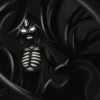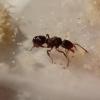two ants, found in the same location. backyard of my home.
one is semi claustral and the other is fully claustral.
SEMI CLAUSTRAL
Date of collection: 14th Octobor
Habitat of collection: Temperate eucalypt forest, mountainous w/ valleys.
Biome specifics: Lots of leaves, concrete tiles with other invertebrates living in the cracks. Poor soil quality with lots of clay and some fine dirt/sand.
Length (from head to gaster): approximately 5-7mm. unsure of how to measure.
Color, hue, pattern and texture: Solid black.
Distinguishing characteristics: Single, pointed petiole in the shape of a knife, large to medium sized head with antennae that are twice as long.
Distinguishing behavior: Very erratic and full of energy. Runs from one side of the tube to the other when disturbed. Drags food into her tube where she tears it apart and places it in front of the larvae, who curl over to eat it themselves.
Nest description: No nest has been found as of writing. Colony is still in founding.
Nuptial flight time and date: Midday, October. Date of collection.
Photos (unedited):
Photos (my physiological understanding):
(this is just what i see, and it is quite likely i have messed this up somehow. but i have decided to do it anyway since the image quality is barely serviceable)


i struggled to figure out where the segments on each antenna were but i think i have it vaguely figured out, and it is reassuring that each time i came up around 9ish.
i can definitely say with confidence that she has a 3 segmented club.
FULLY CLAUSTRAL
Date of collection: 15th Octobor
Habitat of collection: Temperate eucalypt forest, mountainous w/ valleys.
Biome specifics: Lots of leaves, concrete tiles with other invertebrates living in the cracks. Poor soil quality with lots of clay and some fine dirt/sand.
Length (from head to gaster): approximately 4-5mm.
Color, hue, pattern and texture: Very deep brown; Deep brownish black with brown tips of legs and antennae; Black with brown hue.
Distinguishing characteristics: Very fat and swollen gaster, small head, long antennae and stubbier legs.
Distinguishing behavior: Very timid. Moves very little. Has been observed frequently cleaning and rearranging eggs. Feeds workers (2-3mm in size) through trophallaxis despite never being fed (fully claustral). Sluggish.
Nest description: No nest has been found as of writing. Colony is still in founding.
Nuptial flight time and date: Midday, October. Date of collection.
Photos (unedited):
no edited images for this girl. i am afraid the images were too unclear to distinguish anything new by just raising contrast.
if it is needed or wanted, i will make an attempt.
i will also provide with new photos next time i am checking on the ants. it may be a few days yet.
Edited by P0rcelain, December 23 2019 - 12:02 AM.






















